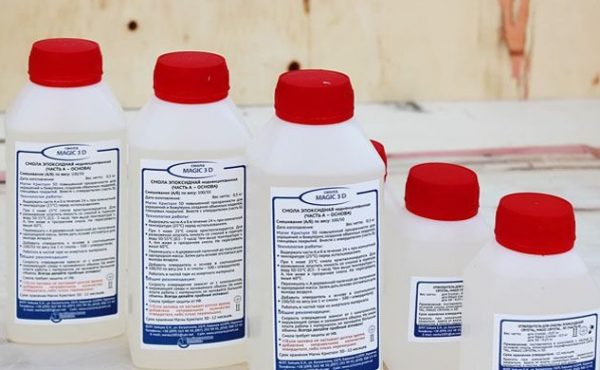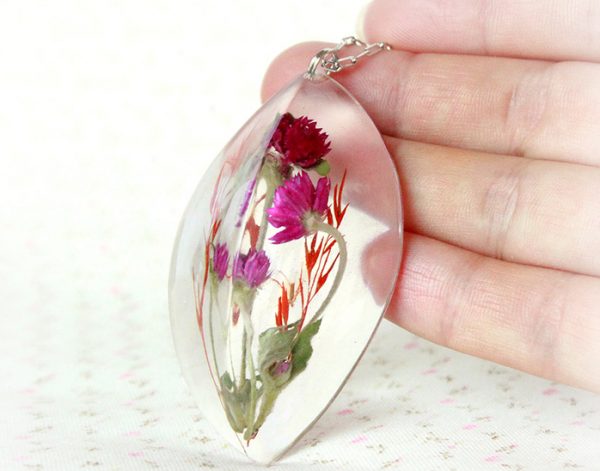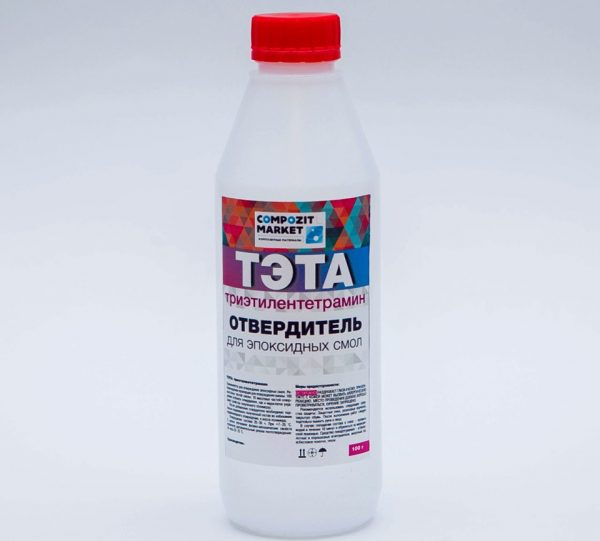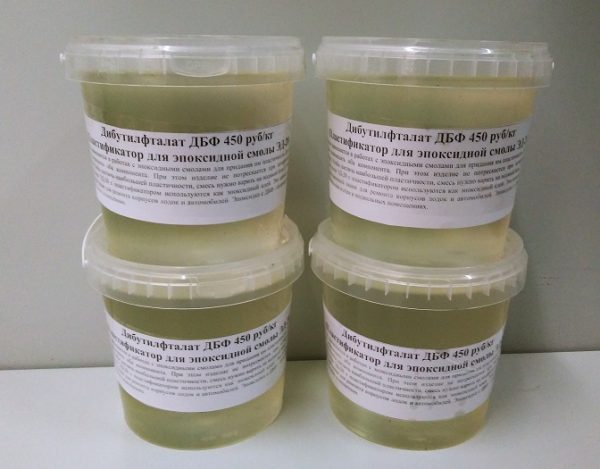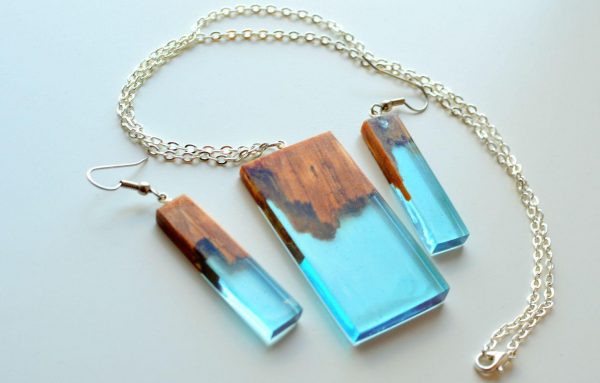Epoxy is a versatile material. The tool is used for the manufacture of bulk floors, various souvenirs and decor, on the basis of the material they make glue, putties, plastic, carbon. Epoxy resin is widely used for creativity: products are incredibly beautiful, their manufacture is possible with your own hands.
- Epoxy resin
- The scope of the material for creativity
- What is the resin
- Transparent
- Color
- The main properties of the resin
- Composition and components for resin
- Hardeners
- Plasticizers
- Fillers
- Solvents
- How to use epoxy
- Dilution of epoxy with hardener
- Large-scale preparation and use
- Use for small items
- Characterization of resin ED-20
- Instructions for use ED-20: proportions of resin and hardener
- Work safety rules
- Resin cost
- Epoxy Products

Epoxy resin
Under epoxy resin understand the oligomer containing epoxy groups, which harden under the influence of special substances - hardeners. In its pure form, the material cannot be used for pouring, decorative work or coating various products: unique properties appear after contact with the hardener, which starts the polymerization process.
The epoxy after curing is safe for health, odorless, transparent, but can be easily painted in different colors. Finished products are not afraid of water, chemicals, alkalis. By introducing different amounts of hardener, it is possible to obtain hard and soft resins that are used for different jobs.
to contents ↑The scope of the material for creativity
After dilution, the epoxy will remain viscous, liquid for some time, so you can fill in various crafts from the material, make jewelry, key rings, accessories, and use in needlework. The composition is poured into molds, and after complete solidification, they are ground and trimmed as necessary. At the end of the work, the craft can be decorated in any technique.
How is epoxy applied in the interior? Thanks to the fill, you can make an original lamp, a vase, paintings and frames for them, panels, products for the bathroom, kitchen. Epoxy resins make bar counters and countertops, shelves and coasters, sinks and sinks. Various pictures under the epoxy are filled with a transparent mass, creating the most incredible compositions.
to contents ↑What is the resin
Epoxy may be different in color. Depending on the need, a transparent or colored resin is chosen.
Transparent
Resin without color (transparent) the most popular in creativity and other fields. This type of epoxy is suitable for the manufacture of 3D paintings, stools and tables, wall panels. The herbarium is filled with transparent material, because the flowers in epoxy look incredibly delicate, stylish. You can fill in a mass of fresh flowers: roses, lilies, individual petals and leaves of plants, depending on the idea. Inside the souvenir are placed marble chips, pieces of granite and even dried insects.
The transparency of the resin allows you to use the material in the manufacture of advertising images, sculptures and figures, jewelry, beautiful jewelry - beads for beads and rosaries, cabochons, bows, bracelets. From epoxy you can make an imitation of precious stones.
The most famous transparent resins:
- Resin Art - the mass for drawing is transparent, it is used in painting and other artwork. It allows you to make art objects and drawings, give the paintings a 3D look, provides them with depth and gloss.
- Magic Crystal-3D. It is used to create vases, candlesticks, handles for knives, various figures, magnets, watch cases, jewelry.
- Epoxy CR 100. Epoxy is transparent, but it is not used for creativity, but in the filling of polymer floors. Sold in large packages.
- ED-20. The well-known epoxy-diane resin can be used both for construction and repair work, and in the creation of various interior items.
Such resins are sold in most large shops of goods for creativity and artists, for example, in Leonardo.
to contents ↑Color
The main difference between colored resins and transparent resins is the addition of dyes. In the manufacture of the material, fillers are introduced into the composition, giving the product a certain shade. The coloring components are sold in a kit with epoxy, sold separately or already included in the basic composition, ready for further use. Colors can be very different: ruby, amber, topaz, jade and others, the material resembles precious stones.
Some resins include luminescent or fluorescent additives, neon pigments, shiny lightning. The epoxy looks original with white diffuser powder, giving it an opaque milky appearance.
With your own hands you can paint the epoxy resin, but getting the color without flakes, clouding is quite difficult. To work, you need to prepare containers, water, dry pigment. Usually, 5-6 drops of dye are enough for 10 ml of the base (it is diluted according to the instructions). The epoxy is thoroughly mixed and proceed with further actions.
to contents ↑The main properties of the resin
Polymer resin lays well on any type of substrate, reliably adheres to metal, plywood, paper, wood and other materials.
The main properties of epoxy:
- high strength, resistance to physical factors and chemicals;
- impermeability to water;
- wide range of applications;
- minimal shrinkage;
- adhesive properties;
- elasticity, but hardness;
- creation of an anticorrosive film on metal surfaces.
The material is a dielectric, which allows it to be used for gluing, filling and insulation of electrical parts. Without the addition of hardener, the epoxy is stored for a long time, does not deteriorate. When working, one must remember that polymerization proceeds at -15 ... + 80 degrees, but the optimum temperature is from +18 to +25 degrees.
to contents ↑Composition and components for resin
Any epoxy is a two-component agent, since it enters the working state only after polymerization (a chemical reaction with a hardener). How to use the resin is always indicated in the instructions for the specific tool. You can change the proportions of the hardener and the base material to obtain different results.
To fill the handle of the knife, the lid for the casket, lamp parts, watches and other bulky products, the mass must be viscous, therefore less hardener is needed. To fill the paper and fabric, cutting board, photographs, nameplates, casting stairs, it is better to make the composition more liquid - more hardener is required.
Not only the amount of hardener affects the state of the epoxy. With thorough mixing, a large number of air bubbles always appear, which spoil the final result. If it is impossible to get rid of the bubbles manually, the solution will have to be heated.
to contents ↑Hardeners
Hardener is the second important component of a two component material. Only in this way can the polymerization process be started. It is important to use a strictly measured portion of the hardener, otherwise the quality of the resin will decrease: moisture resistance, strength, appearance will suffer.
To give a stable structure to the epoxy, carboxylic acid anhydrides, diamines, carboxylic acids themselves are used.Acid hardeners require heating the solution to + 100 ... + 200 degrees, it is difficult to use them at home. Amine hardeners are easier to use: products cause the polymerisation of the resin at room temperature. Special equipment for the use of amines is not required, as well as special skills.
The most popular brands of solutions: PEPA, DETA, RC-19, Epilox H10-40.
to contents ↑Plasticizers
The introduction of a plasticizer helps to give the finished product the ability not to become cracked during physical stress. Plasticizers provide epoxy with sufficient elasticity and the ability to withstand shock, wringing. When pouring a large product (for example, a figure, a monument), the addition of plasticizers is necessary, otherwise cracks will appear soon.
The best plasticizers for epoxy resins:
- Dibutyl phthalate. The DBP agent must be administered in minimum dosages, since the material is difficult to mix with the bulk. It is better to expose the resin to heat, otherwise the plasticizer may peel off.
- DEG-1. Not suitable for transparent resins and those materials whose color cannot be changed. The disadvantage is associated with an orange tint of plasticizer. The product has a plus - the substance is easily mixed with epoxy without heating.
Fillers
All fillers are introduced into the finished resin. They are technical and decorative.
The former make the viscosity too fluid, which is required for construction and repair work (for example, Aerosil, Microsphere, talc, wood powder).
The second color epoxy, provide a new texture (for example, quartz sand, black graphite, different pigments, gloss, mineral chips).
Decorative fillers are widely used in creativity, they allow you to draw with resin on canvas or paper, make beautiful fillings for flowers, cones, other natural material, create jewelry.
to contents ↑Solvents
It happens that during the master class epoxy drips onto clothing or the finished product. You need to hurry up and remove smudges before the material is dry. For this purpose, always have a solvent at hand - acetone, toluene, butyl acetate. They can also dilute the epoxy if the composition is too viscous.
It is necessary to enter solutions cautiously, because even their minimum amount strongly dilutes the resin. The more solvent in the mass, the lower the strength of the material will have after curing. The color of the product may change, as well as the degree of transparency. The disadvantages of adding solvent include longer resin hardening and the risk of microcracks on the surface.
to contents ↑How to use epoxy
When pouring different products, you need to follow the technique of working with epoxy for creativity. It is especially important to observe the recommended proportions of the bulk and hardener.
Dilution of epoxy with hardener
Any manufacturer indicates the exact proportions of the components on the package. This makes the cooking process easier.
The procedure for working with resin:
- Slightly warm up a measured portion of epoxy, making sure that the material does not boil (during crystallization, you need to cool the resin and warm it again to +40 degrees).
- Pour the hardener into the resin.
- Mix the components well with a wooden stick (you cannot use the power tool, this causes the appearance of a large number of air bubbles).
to contents ↑
Large-scale preparation and use
Typically, significant amounts of epoxy are needed to fill in interior items, furniture, tabletops, etc. Difficulties arise with the uniformity of the mass, because it is not easy to mix, like to heat up, and maintain the desired temperature until the resin is filled.
It is generally recommended to use a water bath. The maximum allowable heating temperature is +55 degrees. If this mark is exceeded, crystallization will occur.
to contents ↑Use for small items
Small volumes of resin are useful for crafts - for example, pouring the handle for a knife, lids, jewelry. It is not necessary to heat the resin for small portions. Mixing is done in a cold way, the reaction will still happen in the right way.
Typically, the proportion of resin and hardener is 10: 1 or as recommended by the manufacturer. The resin is mixed gently so that the composition has a uniform consistency without air bubbles.
to contents ↑Characterization of resin ED-20
This is one of the most inexpensive and popular resins on the market. Specifications are good, the cost is small. Unfortunately, the resin has a yellowish tint and cannot be used to create transparent jewelry. When pigments are added, the epoxy can be given a beautiful look and desired color. ED-20 may be part of glue, sealant, used for the manufacture of reinforced plastic.
If you fill only with resin and hardener, after drying the product may be susceptible to cracking. This is due to the initial rigidity of the ED-20, low elasticity and a rather viscous composition. The introduction of a plasticizer will help solve the problem. Under the influence of fire, the resin begins to burn, but does not explode, therefore it does not belong to the most fire hazardous substances. But before drying, the composition is harmful to humans by fumes due to the presence of epichlorohydrin and a toluene solvent.
to contents ↑Instructions for use ED-20: proportions of resin and hardener
Before the introduction of the hardener, it is desirable to heat the resin to +50 degrees - so the viscosity of the working composition is normalized, filling will be easier. It is strictly forbidden to allow water to enter the resinous mass (the material will permanently deteriorate). If necessary, increase the elasticity add a plasticizer in a volume of not more than 2 - 5%.
Further, a hardener may be added to the mass. The temperature of the resin should not exceed + 30 ... + 40 degrees in order to avoid boiling of the mass. Most often, 1 part of the hardener needs 10 parts of the resin, but a different ratio can be used - from 1: 5 to 1:20. The hardener is poured slowly, otherwise a thermal reaction will spoil the resin. Too much hardener or an initially high epoxy temperature leads to the same consequences.
to contents ↑Work safety rules
To work with the material without risk, you must follow basic safety measures:
- use only disposable tableware, which can then be discarded;
- use personal protective equipment: wear glasses on your eyes, and gloves on your hands, do not forget about a respirator;
- when grinding the product, remember about glasses and a respirator;
- if tar gets on the skin, wash the area well with soap and water;
- equip ventilation in the room.
Resin cost
You can buy material in construction stores or in the departments for needlework. The cost varies greatly depending on the brand. For example, for 150 ml of Pebeo gedeo resin you will have to pay about 950 rubles, 300 g of Crystal Resin material costs about 2000 rubles. Pebeo gedeo resin is even more expensive - 1600 rubles per 150 ml. There are cheaper epoxies for creativity, for example, Daily Art - 90 ml costs 450 rubles.
Epoxy Products
From epoxy, you can create a wide variety of crafts. For example, on New Year's Day, May 9, it is possible to make gifts to relatives and friends with their own hands. A vase with dried or natural flowers will look beautiful - even an ordinary dandelion will give the product a delicate appearance. For the bathroom, you can fill the set for soap, brushes with fish, shells.
Countertops with elements of stone and wood look beautiful, furniture of original design. Great imagination can be shown in the manufacture of jewelry - to make a ball for pendants or beads, earrings with crumbs, sparkles, flowers. Epoxy is a versatile material that provides great opportunities for creativity, which experienced needlewomen have long known.



